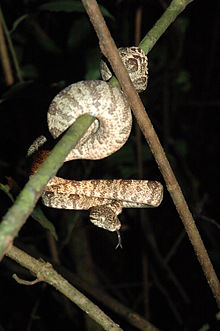- Corallus hortulanus
-
Corallus hortulanus 
Scientific classification Kingdom: Animalia Phylum: Chordata Subphylum: Vertebrata Class: Reptilia Order: Squamata Suborder: Serpentes Family: Boidae Subfamily: Boinae Genus: Corallus Species: C. hortulanus Binomial name Corallus hortulanus
(Linnaeus, 1758)Synonyms - Coluber hortulanus - Linnaeus, 1754
- [Boa] Hortulana - Linnaeus, 1758
- [Boa] Enydris - Linnaeus, 1758
- Boa hortulana - Linnaeus, 1766
- Vipera bitis - Laurenti, 1768
- Vipera madarensis - Laurenti, 1768
- [Coluber] madarensis - Gmelin, 1788
- [Coluber] Bitis - Gmelin, 1788
- Boa Merremii - Sentzen, 1796
- Boa Ambleocephala - Donndorff, 1798
- Boa Merremi - Schneider, 1801
- Boa obtusiceps - Bechstein, 1802
- Boa elegans - Daudin, 1803
- Corallus obtusirostris - Daudin, 1803
- Xiphostoma ornatum - Wagler, 1824
- Xiphostoma dorsuale - Wagler, 1824
- X[iphosoma]. hortulanum - Fitzinger, 1826
- [Xiphosoma] Merremii - Wagler, 1830
- Boa modesta - Reuss, 1830
- Boa hortulana - Schlegel, 1837
- Corallus maculatus - Gray, 1842
- Corallus hortulanus - Gray, 1842
- Xiphosoma hortulanum - A.M.C. Duméril & Bibron, 1844
- Corallus hortulanus - Boulenger, 1893
- Boa hortulana - Ihering, 1911
- Boa hortulana - Griffin, 1916
- Boa enydris enydris - Stull, 1935
- Corallus enydris - Forcart, 1951
- Corallus enydris enydris - Forcart, 1951
- Corallus hortulanus hortulanus - Roze, 1966
- Corallus enydris - Henderson, 1993
- Corallus hortulanus - McDiarmid, Touré & Savage, 1996[1]
Corallus hortulanus is a non-venomous boa species found in South America. No subspecies are currently recognized.[2]
Contents
Description
Adults grow to an average of 5 and 6.5 feet (1.5–2 m) in length.[4] This species exhibits an immense variety of colors and patterns. The basic color can be anywhere from black, brown, or gray, to any shade of red, orange, yellow, or many colors in between[citation needed]. Some are totally patternless, while others may be speckled, banded, or saddled with rhomboid or chevron shapes. Some reds will have yellow patterns, some yellows red or orange patterns. Generally, there are two color 'phases' that are genetically inherited, but are not ontogenic as with the emerald tree boa,C. caninus and the green tree python, Morelia viridis. The 'garden phase' refers to boas with drab coloration, mostly brown or olive, with varied patterning, while the 'colored phase' refers to animals with combinations of red, orange, and yellow coloring.
Geographic range
Found in South America in southern Colombia east of the Andes, southern Venezuela, Guyana, Suriname, French Guiana, Amazonian Brazil, Ecuador, Peru, Trinidad & Tobago and Bolivia. The type locality given is "America."[1]
Typically found below 300 m elevation.
Behavior
These animals are notorious for being very aggressive, although as with all snakes this varies. These animals also have very long needle-like teeth which makes their bite quite painful. However these snakes tend to give some warning of being inclined to bite, and will usually give fairly gentle bites (which can still draw blood) unless they are given reason to give a full on strike, at which point the person concerned will have intimate first hand knowledge of the 20 or so teeth an adult Amazon Boa has available to it.
The aggressiveness is in part due to the species feeding cycle. The snakes are night time hunters, so they are in hunting mode when they are most likely to be handled by an owner. Being in a hunting mood and being that an owners hands are usually nice, hot and prey sized (Amazon Boas hunt mainly using their heat sensors) - people do get bitten, although as with most snakes, the animal will soon realise their mistake and let go, since they can recognise the smell of their owner. It is uncommon for a constrictor snake that knows the person handling it to strike and constrict the person, as they would a food item, unless the snake is very agitated.
These snakes are quite slim and don't have the mass of some of their other constrictor cousins such as the terrestrial Python, Boa and Rat/Corn snake species. Prospective owners however should be advised that while the snake is quite lightweight and gracile in comparison to some other species, it in no way means the Amazon Tree Boa is a weakling. Should an adult snake get around a humans neck the snake is more than capable of constricting the person. It is also more than capable of resisting being moved by both using its strength to anchor itself to the local surroundings, and if agitated striking to defend itself. Male snakes also have spurs under their tail by the vent (the bony remainder of the hips and back legs) and will flail their bodies to bring these into play. The spurs are also used to assist in mating.
A good tip to protect oneself from bites is to wear gloves of some description over the hands, this can shield the heat of the hands and therefore the snake is less likely to strike since it doesnt have a hot target to aim for.
See also
- List of boine species and subspecies
- Boinae by common name
- Boinae by taxonomic synonyms
References
- ^ a b McDiarmid RW, Campbell JA, Touré T. 1999. Snake Species of the World: A Taxonomic and Geographic Reference, vol. 1. Herpetologists' League. 511 pp. ISBN 1-893777-00-6 (series). ISBN 1-893777-01-4 (volume).
- ^ a b "Corallus hortulanus". Integrated Taxonomic Information System. http://www.itis.gov/servlet/SingleRpt/SingleRpt?search_topic=TSN&search_value=563916. Retrieved 14 July 2008.
- ^ Mehrtens JM. 1987. Living Snakes of the World in Color. New York: Sterling Publishers. 480 pp. ISBN 0-8069-6460-X.
- ^ Burnie D, Wilson DE. 2001. Animal. Dorling Kindersley. 624 pp. ISBN 0-7894-7764-5.
Further reading
- Mattison C. 1999. Snake. DK Publishing. ISBN 0-7894-4660-X.
External links
- Corallus hortulanus at the Reptarium.cz Reptile Database. Accessed 14 July 2008.
This Alethinophidia article is a stub. You can help Wikipedia by expanding it.

